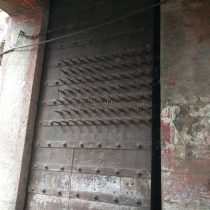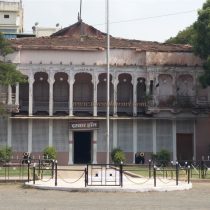ganeshdurg
TYPE : GROUND FORT
DISTRICT : SANGALI
HEIGHT : 0
GRADE : EASY
Sangli district with its ancient history experienced the rise and fall of Shilahar, Chalukya, Yadav, Bahmani, Adilshahi, Mughal, and Maratha powers. There are many different opinions about the name of Sangli city. In medieval times, this region was known as Kundal. Currently, there is a small village called Kundal near Sangli town. Kundal was the capital of the Chalukya Empire in the twelfth century AD. According to some, the place got the name ‘Sangli’ because of the six lanes on the banks of the river Krishna. According to a story, the confluence of the rivers Varna and Krishna joins here, hence the Sangam in Marathi name Sangli. Shivaji Maharaj's general, Netaji Palkar conquered Sangli, Miraj, and Brahmanal from Adilshah in 1669.
...
In 1772, the elder Madhavrao Peshwa gave the fort of Miraj and the surrounding area to Govindrao Patwardhan. During the Peshwa period, Sangli was a part of Miraj Sansthan. These institutions were ruled by the Patwardhan family. After the death of Parashurambhau Patwardhan in 1801, a dispute broke out in the Patwardhan family over the throne, and eventually, Miraj was divided. In it, Sangli was separated from Miraj. This incident took place in the latter part of the Peshwa. Chintamanrao Patwardhan formed a separate Sansthan and established its capital at Sangli, a village on the banks of the river Krishna. He was a major person of Sangli. At the beginning of the nineteenth century, he planned to establish the city of Sangli and built a fort called Ganeshdurg to protect this city. On March 8, 1948, Sangli Sansthan merged with Independent India. The city of Sangli, situated on the banks of the river Krishna, is the headquarters of Sangli district and Ganeshdurg fort is in the center of the village. The moat around the octagonal fort, spread over an area of about 20 acres, is largely dilapidated today, with only two sides remaining. While walking around the fort, one can see two bastions near the moat, two bastions near the main entrance, and five Ganesh Buruj in front of the gate. Four of these bastions are within the ramparts of the fort, but the Ganesh Bastion in front of the gate is different from the ramparts. In front of Rajwada Chowk in Sangli city, you can see the main entrance of Ganeshdurg and the two adjoining bastions. Although most of the fort is urbanized, the ramparts and entrances are in good condition. This is the only north-facing gate in the original construction of the fort. To protect this main gate, two small bastions have recently been built around the gate. The wooden door at the entrance is still in good condition and has spiked nails on it. Above the door is the Nagarkhana and inside is the guard's porch. In front of this gate is a large separate bastion. All these constructions are in Maratha style. Next to this bastion is a door with three arches. The construction of this door, however, is influenced by the English style. Upon entering through this arch, one can see the building of Darbar Hall in front. On the outside of the court, the hall is two cannons with iron wheels. An idol of Ganesha has been erected at the site of the throne on the inside of the Darbar Hall. Except for the inherited building like Darbar Hall, most of the fort is occupied by the government and small and big shops. There is also a small museum in the fort. The fort has two new gates on the south and east sides.
© Suresh Nimbalkar




